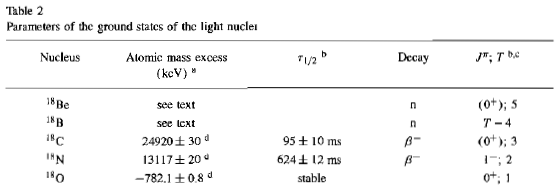Evaluation Home Page |
| Information on mass chains and nuclides |
|
|



18Ne (1995TI07)
(See Energy Level Diagrams for 18Ne)
GENERAL: See  3 [Electromagnetic Transitions in A = 18-19] (in PDF or PS),
3 [Electromagnetic Transitions in A = 18-19] (in PDF or PS),  18.35 [General Table] (in PDF or PS) and
18.35 [General Table] (in PDF or PS) and  18.36 [Table of Energy Levels] (in PDF or PS).
18.36 [Table of Energy Levels] (in PDF or PS).
For B(E2) of 18Ne*(1.89) and other parameters see (1987RA01) and  2 in the Introduction.
2 in the Introduction.
| 1. 18Ne(β+)18F | Qm = 4.446 |
The half-life of 18Ne is 1672 ± 8 ms: see (1978AJ03) and (1983AD03). The decay is primarily to 18F*(0, 1.04, 1.70 MeV). In addition there is an extremely weak branch [(2.07 ± 0.28) × 10-3%] to 18F* (1.08 MeV) [Jπ = 0-; T = 0] (1983AD03): see  18.33 (in PDF or PS) for the parameters of the decay. The parity mixing in the 18F*(1.04, 1.08) 0+ - 0- doublet has been studied by (1983AD03). It has been proposed as a probe of T-odd nuclear forces (1992HE12). See also (1982HE04). For the earlier work see (1983AJ01, 1987AJ02).
18.33 (in PDF or PS) for the parameters of the decay. The parity mixing in the 18F*(1.04, 1.08) 0+ - 0- doublet has been studied by (1983AD03). It has been proposed as a probe of T-odd nuclear forces (1992HE12). See also (1982HE04). For the earlier work see (1983AJ01, 1987AJ02).
| 2. 12C(12C, 6He)18Ne | Qm = -22.913 |
This reaction was studied at 6He angles from 0° to 10° with a magnetic spectrometer (1992HAZZ). New levels at Ex > 6 MeV, including 18Ne*(6.15, 7.35 MeV), were found. Astrophysical implications are discussed.
| 3. 14O(α, γ)18Ne | Qm = 5.112 |
The thermonuclear reaction rates for this reaction have been estimated (1987WI11) using information from the isobaric analog 18O. A new 18Ne level at Ex = 6.15 MeV (see 16O(3He, n)) has been observed (1990GAZW) which may play a role in 14O + α burning. See also (1988CA26).
| 4. 14O(α, p)17F | Qm = 1.190 |
This reaction is considered important in the generation of Z ≥ 10 nuclei from products in the hot CNO cycle. Microscopic multichannel calculations for this reaction are discussed in (1988FU02, 1989FU01).
| 5. 16O(3He, n)18Ne | Qm = -3.196 |
See  18.38 (in PDF or PS). See also (1983AJ01).
18.38 (in PDF or PS). See also (1983AJ01).
Recent work reported in (1991GA03) found that the 3+ level in 18Ne predicted by (1988WI08) occurs at Ex = 4.561 ± 0.009 MeV. Astrophysical consequences are discussed. New levels in 18Ne at Ex ≥ 6 MeV observed in 16O(3He, n) were reported in (1990GAZW). [See discussion under 14O(α, γ)18Ne.] See also (1989GAZW, 1990GAZR). For applied work related to this reaction see (1991GU05, 1992DI04).
| 6. 16O(α, nn)18Ne | Qm = -23.773 |
See (1991GU05) for measurements at Eα = 40 MeV.
| 7. 16O(10B, 8Li)18Ne | Qm = -18.951 |
At E(10B) = 100 MeV, the angular distribution to 18Ne*(3.38) [(d5/2)24+ state], which is preferentially populated, has been studied. 18Ne*(1.89) is also observed (see (1983AJ01)). See also (1983OS07).
| 8. 16O(12C, 10Be)18Ne | Qm = -22.663 |
Measurements at E(12C) = 480 MeV are reported in (1988KR11, 1988ME10). The 4+ level at Ex = 3.38 MeV is observed.
| 9. 18O(π+, π-)18Ne | Qm = -6.101 |
Angular distributions have been studied at E(π+) = 164 and 292 MeV [see (1983AJ01)] and at 48.3 MeV (1985AL15; to 18Neg.s.) and 100 to 292 MeV (1985SE08; to 18Neg.s.). The excitation functions for production of 18Ne*(0, 1.89) have been measured for E(π+) = 80 to 292 MeV: see (1983AJ01, 1985SE08). See also (1987AJ02).
The behavior of double charge exchange (DCX) cross sections at low energies (50 ± 30 MeV) was reviewed in (1987PA1H, 1988SE1A, 1989BA1R). See also the review of (1989ST1H). Measurements at energies of 300 - 500 MeV above the Δ(1232) resonance were reported in (1989WI02). More recently a search for an η bound state in this reaction is described in (1992JOZZ, 1993JO03).
The contribution of the two-nucleon pion absorption emission mechanism is discussed in (1990CH14). See also (1989CH1O, 1990CH1U) and see (1989YU1A). A quark-antiquark annihilation mechanism is proposed in (1989CH21). A two-amplitude model for the DCX energy dependence is described in (1989FO02). In other recent work, the contribution of sequential charge exchange and δ-nucleon charge exchange is examined in (1993GI03). Absorption contributions near Tπ = 50 MeV are evaluated by (1992OS05). High energy DCX and isovector renormalization is calculated and compared with data in (1993OS01). See also (1992MA46) for a discussion of dibaryon effects.
| 10. 20Ne(p, t)18Ne | Qm = -20.022 |
Observed triton groups are displayed in  18.38 (in PDF or PS) as are Jπ derived from DWBA analysis of angular distributions: The 0+3 state, identified at Ex = 4.59 MeV, appears to have a largely s21/2 configuration based on its large downward shift with respect to the analog state in 18O (1981NE09).
18.38 (in PDF or PS) as are Jπ derived from DWBA analysis of angular distributions: The 0+3 state, identified at Ex = 4.59 MeV, appears to have a largely s21/2 configuration based on its large downward shift with respect to the analog state in 18O (1981NE09).
| 11. 20Ne(3He, nα)18Ne | Qm = -7.926 |
See (1991GU05).
